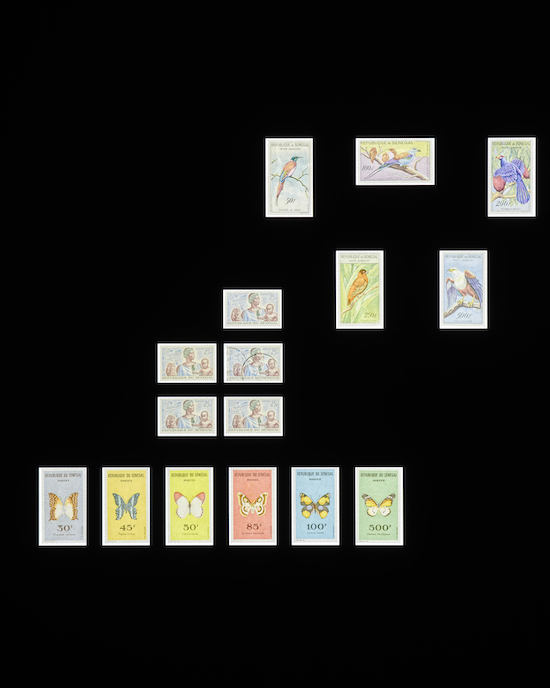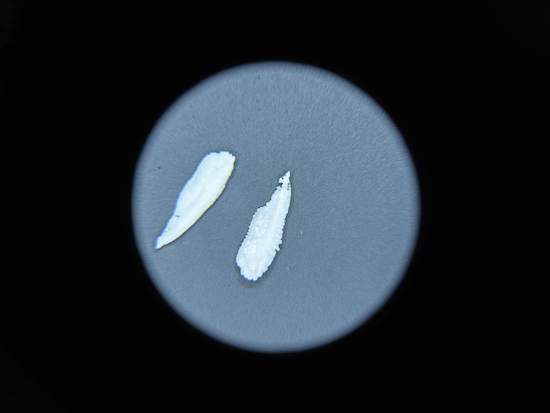All photos: Ros Kavanagh
The Otolith Group is a collective formed by Anjalika Sagar and Kodwo Eshun back in 2002. They take their name from a tiny structure made from calcium carbonate that sits in the inner ear and allows us to perceive motion, acceleration in both the vertical and horizontal axes. Their name is a neat metaphor as it captures the essence of the group’s practice: a fundamentally research based programme that destabilizes and questions received ideas, interrogates ignored archives, rediscovers and realigns forgotten stories. They dig instability and want to throw you, set you off balance, and make your thoughts dizzy with endlessly questioning. Their works include lightboxes, books, films, mirror and digital screen installations. Their work is brainy and complicated and flies against the restrictive Joycean nets thrown at us all; they gleefully admit to being verbose because there’s a lot to talk about.
The guiding spirits of this cross section of work (the group are adamant this is not a retrospective – they’re not old!) are three other artists: writers Octavia Butler and Rabindranath Tagore, and the composer Julius Eastman. Butler’s Xenogenesis trilogy of science fiction novels (1987–1989) supplies the title of the exhibition and we might understand the word as meaning “becoming strange”. Sagar talks of “alienating yourself from the perceivable world”, what she calls a “productive alienation”. Thus the exhibition’s curator Annie Fletcher also asks us to be open here to “what Mark Fisher called ‘the weird’ or ‘the eerie’”. Fisher is another of the subversive ghosts at this visual feast. His thinking on psychedelia and his worry that de-psychedelisation is an aspect of what he called ‘capitalist realism’ is informed by Anathema (2011), one of the HD video works here that magnifies elements of liquid crystal technology used in digital advertising.
The Otolith Group is right into music. The video People to be Resembling (2012) features the 1980s ECM trio Codona – Collin Walcott, Naná Vasconcelos and Don Cherry – who mixed free jazz with non-Western music. Walcott died in 1982 and so there is very little film of them performing; the work here combines unpublished photos of the band collaged with their sounds. Eshun talks of the band’s “non-dualistic way of thinking” and how the imagery we have of the group might conjure what Fred Moten calls “phonic substance”, a visible music seen in the pictures. These conjunctions work quite beautifully: here we see a paradox, a rhythm of creative life in static shots.
The transgressive composer Julius Eastman features in the video The Third Part of the Third Measure (2017). Sagar and Eshun are angry that Eastman’s name is nowhere near as well known as that of other contemporary (white) composers like Steve Reich and Philip Glass. In the accompanying book on the exhibition (a stunningly produced affair) Eshun is quoted as saying that if Eastman can be erased “what does that say about other black avant-gardists in the US? If they can all be erased what is there to prevent us from disappearing?”

Eshun is talking to me about stamps. We’re standing in front of Statecraft: An Incomplete Timeline of Independence Determined by Digital Auction (2014-2019) – an enormous installation that features a long wall that curves somewhat to the left (“a Nabokovian bend sinister” he notes). On either side of the black wall are African stamps bought on eBay. What we have then is a kind of archive of African postal politics, images of smiling dictators, remnants of what Eshun calls the “fissiparous proliferation of newly independent nations”. The tragedy of Congo’s Patrice Lumumba is referenced. And then Eshun points to stamps from Zanzibar in 1964 that feature the recently deposed Sultan. These have been overprinted by the new regime with the word JAMHURI, which means ‘republic’. We talk about the major relevance of such interventions here in Ireland. As a boy at the school philately club, a rogue priest once showed us British stamps overprinted by the IRA. My old man went ballistic…
In the Year of the Quiet Sun (2013) is a complimentary work that highlights the postal politics of 1960s Ghana and the impact of various coup d’états aimed against the Pan-African ideals of the period. Whilst making this film the collective noted the recurrent image of a 1907 statue featuring women circling the globe. This was a monument to the Universal Postal Union, an organization that is supposed to maintain standards for postal communication. The statue is in Bern, Switzerland. Sagar notes that the bronze goddesses “are white symbols that embody an imperial fantasy of universal communication” and questions “why does this dream of communication require these patriarchitectural vessels of female virtue?” In turn the Group then made Sovereign Sisters (2014), a digital animation of said Swiss sculpture that “reduces this granite and bronze neoclassical imagery to the visualization of data in a point cloud”. Rarely has such a polemical work, indignantly out to undermine its original authors, looked so pretty.
Given their interests, The Otolith Group can be viewed as unapologetic modernists: there are references here to Gertrude Stein and her talk of “completely thinking about some of the things he was thinking”. There are no postmodern japes here: no Damien Hirst-style trivialities. The Group knows we live in serious times that demand careful, detailed, cross-examination.
There is, unsurprisingly given the catastrophe of what Jason Moore calls ‘the Capitalocene’, a deep pessimism underpinning The Otolith Group’s thinking. But there are utopias to be considered and this is where Tagore comes in. Their film O Horizon (2018) studies the ideas behind Santiniketan, a campus community set up by the Nobel laureate in 1921. Here is a video portrait underpinned by Tagore’s antipathy to his colonial education in Brighton, a hymn then to autodidactic principles and a life of potent curiosity. We hear his poetry aimed at listeners in the future. There is dance and music and song, all in flux, an imagery of constant movement and flow. And there’s much too on soil science, a reminder that we will, one day, all return to the earth. Hard not to be reminded here of the Codona-inspired David Sylvian and Jon Hassell with their song ‘Brilliant Trees’ and its achingly resigned concluding line about “leading my life back to the soil”.
A glib summation of this show might also mention benign paroxysmal positional vertigo (BPPV): the sudden sensation that you’re rotating, or that the inside of your head is spinning. We might take the condition as another metaphor for understanding The Otolith Group here in Ireland. Their intent is not malignant but a benevolent attempt to realign your thinking; theirs is a gently pulsating destabilization that asks – where am I, what do I think of that? What do I know? The exhibition demands close attention: there’s a lot to take in. Leaving IMMA you’re reminded of Joyce’s Bloom as he frequently sings to himself, you’re head it simply swirls.
The Otolith Group, Xenogenesis, is at the Irish Museum of Modern Art until 12 February 2023


